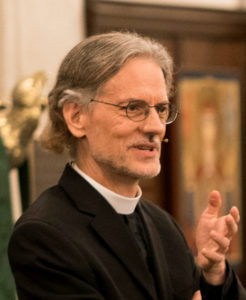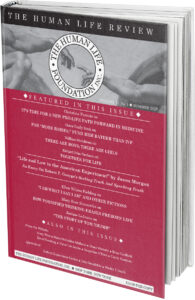Barbie—Breaking Through
One is not likely to think of Barbie as a pro-life film. Its premise is that there is a “Barbieland” ruled by women, an excessively pink world of upbeat and positive people who never age, perfect in skin and attitude. It is not a world of sin and hardship, where people age and grow old and die, nor a world where babies are born. Yes, there is Pregnant Barbie, but she is something of an outlier, and of course she remains Pregnant Barbie forever, never giving birth.
Nonetheless, this film sets up viewers to see things that the pro-choice lenses of our elite culture (in which I include Hollywood) normally filter out. In other words, it is a film where convictions dear to pro-life people can “break through” into the wider culture. We need to pay attention to cultural moments like this. We need to notice and celebrate them when they happen. Indeed, if we can, we need to contribute to them. My readers may know that on June 29 the Human Life Foundation is sponsoring a conference on this very theme. This column is what my friends would never have thought possible: yours truly declaring that he enjoyed watching Barbie.
It would be hard to say that Barbie puts forth a single interpretation of man-woman relations. The plot hangs on the understanding that in Barbieland women can be anything they want to be. The embarrassment around Pregnant Barbie is voiced by the head of Mattel, who throughout the film asks, “Didn’t we withdraw her?” Still, in Barbieland the president, supreme court justices, doctors, construction workers, all are women. “Every night is girls’ night . . . forever,” proclaims Stereotypical Barbie.
But then Stereotypical Barbie (she’s the original) starts thinking of death and gets a few wrinkles and a little cellulite. She is told (by one called Weird Barbie) that this is because a hole has opened up between Barbieland and the real world and, in the latter, someone is messing with her. Barbie is perplexed that a girl, who is playing with her as a doll, could be sad and thus sending thoughts of dying and aging to her. “We’ve fixed everything,” Barbie says, “so that all women in the real world can be happy and powerful.” She sets off to find the source of this interference and thereby save herself from change and decay and sadness and becoming “complicated.” At the party for her just before she departs Barbieland, there is a banner that nicely sums up Barbie’s mission: “Bon Voyage to Reality and Good Luck Restoring the Membrane that Separates Our World from theirs so you don’t get Cellulite!”
Barbie is surprised to discover that her picture of the human world is deeply wrong. Instead of Barbie dolls having made girls and women there capable of doing anything, those girls and women, or least some of them, hate her, even as they hate how women are treated in their world, which, as Barbie learns, is fundamentally patriarchal. (A subplot unfolds when Ken, who has come along undesired, discovers patriarchy and tries to turn Barbieland into a Kendom.) Barbie’s misunderstanding produces comic moments, such as when she approaches some construction workers at lunch break and is surprised they are all men and not all women. When they taunt her sexually, she proudly replies that she has no vagina, and that Ken (who is following her) has no penis. “We don’t have genitals,” she says, walking past with a perfect smile, her lovely chin in the air.
Thus, implicitly but not overtly, the film poses the questions: What would the world be like if men and women had no sexual organs? No children? Never aged? Never died? And with these questions a thought slips into the viewer’s mind, the thought that, considering everything, maybe it’s good that we are made the way we are.
At the end of the film, Barbie has a significant conversation with Ruth, the elderly woman who created Barbie decades ago. Barbie wants to know about becoming human, and Ruth wants to make sure she understands the implications of that choice. Ruth points out that ideas live forever; “humans, not so much.” Barbie says she wants to be one of those who do the imagining, not merely the idea that is being imagined. She decides to embrace mortality, its wrinkles, its decay, its change, its uncomfortableness.
Barbie also asks Ruth if being human is something one simply discovers one is. Ruth takes Barbie’s perfect young hands in her own old ones, telling her to close her eyes and feel. What follows is a series of images of women: babies and bottles, toddlers being swirled around, young children playing together, adolescents, a college graduation, a parachutist, a bowling game and many other very short scenes, including one of elderly adults dancing. At the end of this sequence, we see a girl in a field with flowers in her hands. In the subsequent and final scene, Barbie enters an office, gives her name to the receptionist, and when asked why she is there, delivers the punchline of the film: “I’m here to see my gynecologist.”
In other words, Barbie is glad to be a real woman. Through these climactic images, Barbie breaks through to affirm the human importance of every stage of life, all the different races and conditions, and in particular the importance of transmitting life to future generations. Of course, Barbie leaves things out—every movie must—and any serious movie will be open to multiple interpretations. Yet I think no one could deny that in Barbie something about the significance, the transcendence, indeed the sacredness of human life breaks through, something capable of touching hearts and moving souls.











I didn’t watch the whole movie, but it begins with little girls supposedly oppressed because motherhood is the only option who are playing with dolls. When they see the Barbie Idol, they start throwing their babies away.